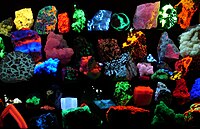
Photo from wikipedia
We present a simple optical capability for generating spatially resolved chemical concentration maps of mixing fluids using a chemically sensitive dye, 1-hydroxy-3,6,8-pyrenetrisulfonic acid, detected by planar laser induced fluorescence. To… Click to show full abstract
We present a simple optical capability for generating spatially resolved chemical concentration maps of mixing fluids using a chemically sensitive dye, 1-hydroxy-3,6,8-pyrenetrisulfonic acid, detected by planar laser induced fluorescence. To demonstrate an application of this capability, we investigate the collision and mixing of a pair of microdroplets in air. The two microdroplets are composed of different fluids, methanol and water, with the dye initially in the methanol droplet. When the droplets collide and mixing process develops, the fluorescence of the dye shifts from blue to green as the solvent environment changes. A series of spectral-temporal images of the collision and subsequent mixing are recorded, from which we extract the distribution of the two intermixing droplet species reflected in the spatially resolved dye spectra. Images reveal material transfer between droplets in both coalescing and non-coalescing droplet collisions.
Journal Title: Physics of Fluids
Year Published: 2023
Link to full text (if available)
Share on Social Media: Sign Up to like & get
recommendations!